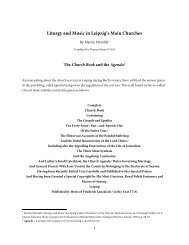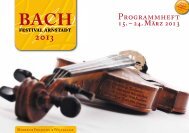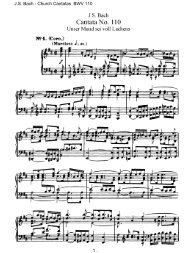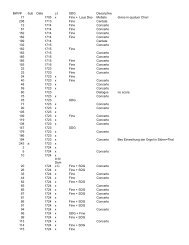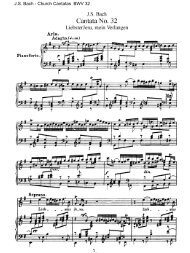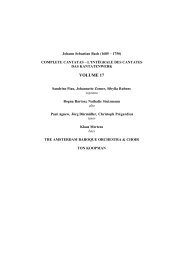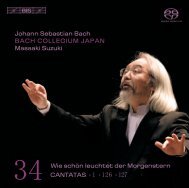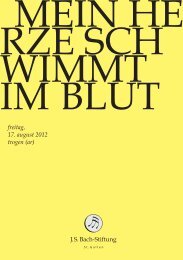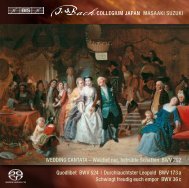Bach Cantatas, Vol. 2 - F. Werner (Erato 10-CD)
Bach Cantatas, Vol. 2 - F. Werner (Erato 10-CD)
Bach Cantatas, Vol. 2 - F. Werner (Erato 10-CD)
You also want an ePaper? Increase the reach of your titles
YUMPU automatically turns print PDFs into web optimized ePapers that Google loves.
the beginning of the Schtibler Chorales. The unity of the work is based on the way in which its form<br />
is conceived, and also on the fact that its most important motifs are derived from the hymn tune.<br />
Gott, der Herr, ist Sonn und Schild, BWV 79 was probably written for Reformation Day (31<br />
October) 1725. Similarly to <strong>Cantatas</strong> 77 and 78, it is concentrated almost entirely on the opening<br />
chorus; but from the point of view of content it is uninterruptedly dominated by gratitude and joy,<br />
making it a work of demonstrative and outgoing character. This is clear in the orchestral scoring,<br />
with horns and kettledrums, oboes, strings and continuo, to which flutes were added in subsequent<br />
performances. The orchestral prelude features the chorus bringing forth all the splendour<br />
appropriate for this particular day: a festive horn theme, then a lively fugato, and then both themes<br />
combined. The first choral sections are accompanied by the fugal theme and punctuated by the horn<br />
theme, and then a choral fugue develops from the instrumental fugue theme. Finally, the first choral<br />
section, freely repeated, is built into a repetition of the beginning and conclusion of the instrumental<br />
introduction. The alto aria which follows turns the jubilant note heard so far into an intimate and<br />
individual contemplation, although the text continues to speak of the congregation. The chorale<br />
once again takes up the horn theme of the first chorus and thus rounds offthe three first parts of the<br />
work into one unit. Perhaps the sermon originally followed at this point. The movements which<br />
then follow are at any rate lightweight compared with the powerful first section of the cantata, and<br />
are of a markedly simple construction. In the concluding chorus, horns and kettledrums once more<br />
establish a relationship with the festive splendour of the opening half of the cantata, in keeping with<br />
the text ofthe chorale.<br />
<strong>CD</strong>8<br />
Ein feste Burg ist unser Gott, BWY 80, in the present version probably a late cantata for the Feast of<br />
the Reformation (1732), resulted from the rearrangement and expansion of the cantata Alles, was<br />
von Gott geboren,BWY 80a, composed in 1715 in Weimar for the Third Sunday in Lent. In view of<br />
the fact that this was a "quiet" Sunday in Leipzig, that the appropriate cantata for this Sunday dealt<br />
with Satan's war against God and, furthermore, that Luther's hymn Ein feste Burghad already been<br />
56



